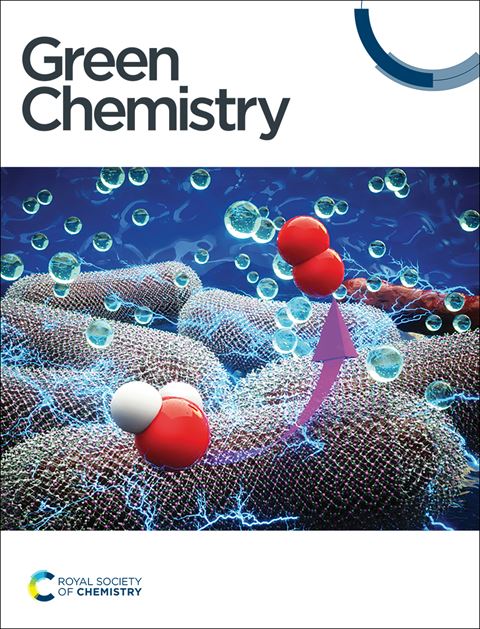环胺作为改善木质纤维素生物质加工的溶剂的多尺度计算筛选和机理研究
IF 9.3
1区 化学
Q1 CHEMISTRY, MULTIDISCIPLINARY
引用次数: 0
摘要
木质纤维素生物质是一种很有前途的原料,用于从可再生资源中生产负担得起的燃料和化学品。其纤维素、半纤维素和木质素组分的有效溶解和随后的分解对未来生物精炼厂的可行性至关重要。本研究使用基于量子化学的平衡热力学方法来评估650种环胺对纤维素、半纤维素和木质素的溶解潜力。采用cosmos - rs (Real solvent - conductor -样筛选模型)方法预测溶剂-生物聚合物相互作用的活度系数,并用于识别在生物质预处理过程中可以有效溶解和提取生物聚合物选择性组分的环胺。在650种环胺中,1-哌嗪乙胺被预测为提取这三种聚合物的有效溶剂,实验表明木质素去除率最高(97.1%)。通过非共价相互作用、降低密度梯度和量子化学计算来阐明木质素、纤维素和半纤维素的溶解机制,并进一步从分子水平上了解环胺与生物质聚合物之间的相互作用,从而促进有效的增溶和提取。这些分析表明,1-哌嗪乙胺和1-甲基咪唑与木质素发生非共价范德华作用、静电相互作用和氢键作用,从而增强了木质素的去除,而纤维素和半纤维素中强的分子内氢键相互作用导致溶剂与生物聚合物的相互作用减弱。总的来说,计算方法提供了一种有效的方法来识别适合最佳生物质预处理的环胺,并导致识别一种潜在的新型有效生物质预处理溶剂。本文章由计算机程序翻译,如有差异,请以英文原文为准。
Multi-scale computational screening and mechanistic insights of cyclic amines as solvents for improved lignocellulosic biomass processing†
Lignocellulosic biomass is a promising feedstock for production of affordable fuels and chemicals from renewable resources. Effective solubilization and subsequent deconstruction of its cellulose, hemicellulose, and lignin fractions is essential for the viability of future biorefineries. This study used quantum chemistry-based equilibrium thermodynamics methods to evaluate the potential of 650 cyclic amines to solubilize cellulose, hemicellulose, and lignin. The activity coefficients of solvent - biopolymer interactions were predicted using the COSMO-RS (COnductor-like Screening MOdel for Real Solvents) method and used to identify cyclic amines that can efficiently dissolve and extract selective fractions of biopolymers during biomass pretreatment. Among the 650 cyclic amines, 1-piperazineethanmaine was predicted to be an effective solvent for extracting all three polymers and was experimentally shown to achieve the highest lignin removal (97.1%). Non-covalent interaction, reduced density gradient and quantum chemical calculations were performed to elucidate the dissolution mechanism of lignin, cellulose and hemicellulose and gain further molecular level insights into the interactions between the cyclic amines and biomass polymers that promote efficient solubilization and extraction. These analyses indicated that 1-piperazineethanmaine and 1-methylimidazole make noncovalent van der Waals, electrostatic interactions and hydrogen bonding with lignin, leading to enhanced lignin removal, while the strong intramolecular hydrogen bonding interactions in cellulose and hemicellulose result in weaker solvent-biopolymer interactions. Overall, the computational approach provided an efficient method for identifying cyclic amines tailored for optimal biomass pretreatment and resulted in the identification of a potential new class of solvents for effective biomass pretreatment.
求助全文
通过发布文献求助,成功后即可免费获取论文全文。
去求助
来源期刊

Green Chemistry
化学-化学综合
CiteScore
16.10
自引率
7.10%
发文量
677
审稿时长
1.4 months
期刊介绍:
Green Chemistry is a journal that provides a unique forum for the publication of innovative research on the development of alternative green and sustainable technologies. The scope of Green Chemistry is based on the definition proposed by Anastas and Warner (Green Chemistry: Theory and Practice, P T Anastas and J C Warner, Oxford University Press, Oxford, 1998), which defines green chemistry as the utilisation of a set of principles that reduces or eliminates the use or generation of hazardous substances in the design, manufacture and application of chemical products. Green Chemistry aims to reduce the environmental impact of the chemical enterprise by developing a technology base that is inherently non-toxic to living things and the environment. The journal welcomes submissions on all aspects of research relating to this endeavor and publishes original and significant cutting-edge research that is likely to be of wide general appeal. For a work to be published, it must present a significant advance in green chemistry, including a comparison with existing methods and a demonstration of advantages over those methods.
 求助内容:
求助内容: 应助结果提醒方式:
应助结果提醒方式:


